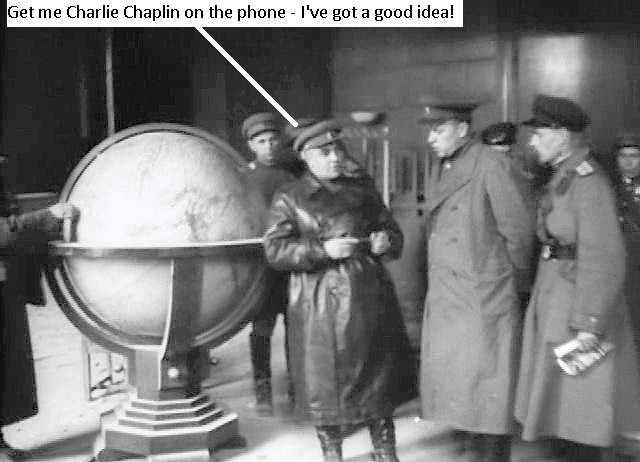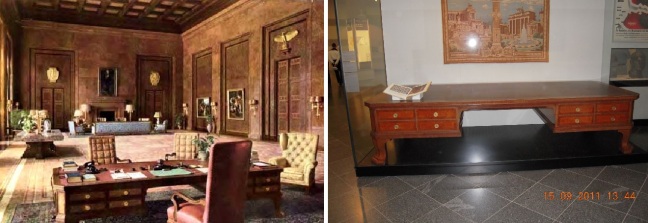Don’t believe all you read about this subject, i.e. the New Reich Chancellery. For example, if you go to the Zeughaus German History Museum on Unter den Linden (which is highly recommended) you will see this globe:

… complete with vengeful Russian bullet hole through Germany:

However, all is not as it seems. This globe is probably not the one from Hitler’s study:
The fact of the matter is that there were several of these globes and many were destroyed after the battle so correctly identifying which one went where is nowadays so far impossible. Here are some – surely not posed – Soviet photos:




but consider these photos, all taken in the vicinity of the NRK. The Russian officers in the first one are standing outside the French windows to Hitler’s office:

As a matter of interest, they are standing on a landing outside Hitler’s office on which the bronze horses – previously mentioned – were also standing.

If they were to walk to our left a metre or two, they would be standing above where Hitler had decorated the HJ boys a few days earlier:

In the next post, I’ll demonstrate where that HJ ceremony happened in terms of today’s geography but for the moment, back to the globes. Here’s a couple:

That blue arrow indicates the greenhouse which stood facing Hitler’s office (an ornamental pond stood between the greenhouse and the landing with the two bronze horses) so we know these two globes are in the immediate vicinity of Hitler’s office. There was a globe of this sort in Hitler’s office and another in the Reich Cabinet Room. In the photos of Russians above, photos 3 and 4 show the globe in the Reich Cabinet Room. The following photos – unless they are of the same destroyed globe (and I think the first two are) – would seem to suggest that Adolf must have had a Valued Customer Account at Globes R Us:



The safest that can be said of any surviving globes is that each is ‘one of‘ Hitler’s globes.
More on the globes here:
https://forum.axishistory.com/viewtopic.php?f=44&t=125876
but be aware that not all of the correspondents know what they’re talking about. Even those who were ‘there’ are sometimes mistaken, for example the Australian Neal Carter describes Hitler’s office as being ‘twenty foot square’ (it was 20 metres by 14.5) and describes two glass chandeliers (there were none in Hitler’s office). To be fair, he did say they were told they were in Hitler’s office but even if they were in the Great Reception Hall we still have the problem of “twenty foot square” …
And here’s another trap for the unwary. This desk is in the same Zeughaus Museum:

and is described as “Hitler’s desk”. However, notice that the front is placed against the wall. I wonder why? Could it be to hide the distinctive inlay work of which Hitler was so proud? This inlay is described in Albert Speer’s “Inside the Third Reich” (page 172 in my Australian 1971 edition) and he quotes Hitler as saying “Good, good … when the diplomats sitting in front of me at this desk see that, they’ll learn to shiver and shake”. This is a reference to the middle section which Hitler saw as depicting a sword being unsheathed although how he could tell it was being unsheathed and not sheathed has got me buggered. Here’s a comparison of Hitler’s (real) desk in the NRK and the one in the DHM:

Looks pretty good, eh? However, unless we can see the front we can’t be sure. I’m almost certain that the one in the DHM is not the one from Hitler’s office in the NRK. Apparently when things got sticky all the good stuff – carpets, desks etc – were packed off to Munich (or more likely Berchtesgaden) for safekeeping:
https://forum.axishistory.com/viewtopic.php?f=44&t=125876&start=45
Here’s the front view – courtesy of Pinterest – of the desk with the sword motif in the middle:

…and here it is in situ in colour:

Source: Pinterest
But consider this:

and:

Notice anything? The last two photos have no inlay work on the front. We know that the inlay version was in place when the NRK was opened so why was it moved? It would probably not have been moved to storage when these photos were taken because the tapestry would have gone too. The desk in the last two photos appears – like the globes – to be a generic thing as there are a number of photos of such desks. Here’s one, probably at the Bischofswiesen Reich Chancellery outside Berchtesgaden or in the Berghof:

So the moral of the story is don’t believe everything you’re told and don’t lay out a lazy 5 mill or so on a genuine Hitler desk.

Interesting about the ersatz desk, but going by the leg you at least can sleep soundly knowing the one in the DHM isn’t the knockoff. But if it’s not that, and it’s not the original, what is it? Why would they hide the front?
LikeLike
Michael: these were a pattern desk. There were several others – in the chancellery in Berchtesgaden, for example. The real (Hitler) one was the only one with the easily-recognisable drawn- sword motif. That’s why, IMO, the one in the DHM is facing the wall: if the punters don’t see a drawn-sword motif they know they’re being sold a pup. Ray Cowdery in his book claims to have ‘examined’ the real desk in Munich in 1994 but I find this hard to believe as he makes one or two other questionable statements in an otherwise excellent book. Cheers!
LikeLike